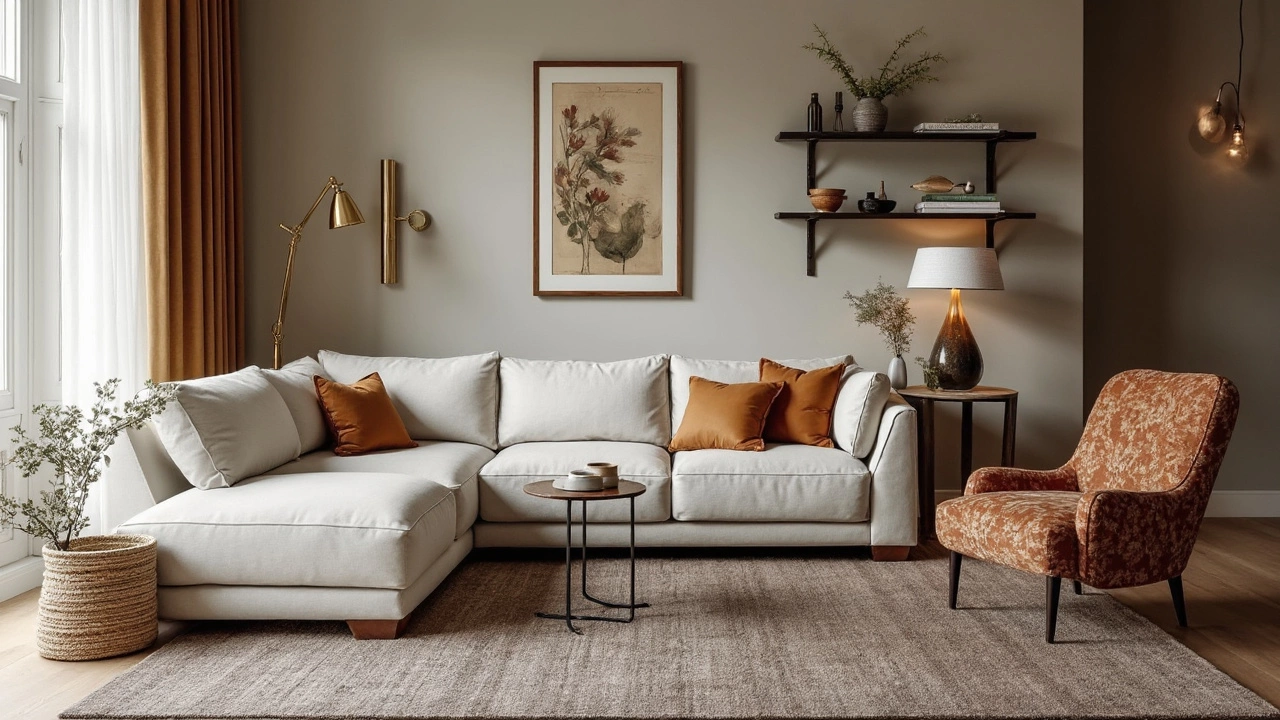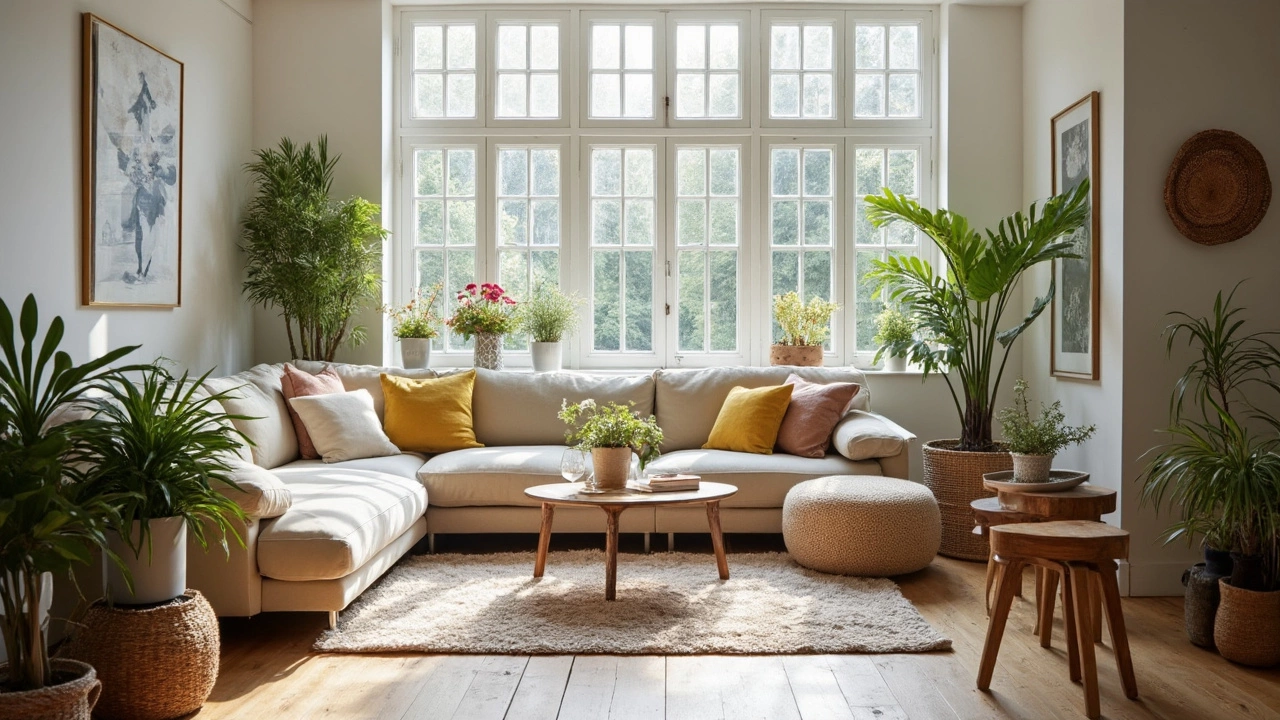Seen a couch shoved up against the wall in almost every living room? It's almost like an unwritten rule. But is it actually a good idea, especially with corner sofas? Turns out, you could be missing out—big time—on space, comfort, and style.
Dragging your sofa away from the wall changes everything. Suddenly, the room feels more open, even bigger. There's a real chance for your furniture to 'breathe,' and that just makes the whole space more inviting. Plus, you'll be surprised at how your room's traffic flow suddenly feels a lot smoother, with no more awkward squeezes between furniture and walls.
- Space Flows Better When the Couch Floats
- Let the Room Breathe: Light and Airiness
- Conversation Zones and Cozy Corners
- Making Your Corner Sofa a Style Statement
Space Flows Better When the Couch Floats
Pushing your corner sofa right up against the wall can block the natural flow of your living room. When you give the sofa space—meaning you "float" it a few inches or even a foot away from the wall—you open up pathways that help people walk around without bumping into furniture or each other. This trick actually works no matter how small or big the room is.
Open walkways make everyday life easier. If you have kids or pets, they can skootch across the room without diving over armrests. Even vacuuming and dusting are a breeze when furniture isn’t mashed up against the wall. Letting your corner sofa float can turn traffic jams into smooth strolls.
Here's what happens when the sofa isn't glued to the wall:
- Visitors have more room to move, so the space feels less cramped.
- You naturally make “zones” for reading, chatting, or watching TV—so the room doesn’t feel like one boring rectangle.
- The back of the sofa becomes usable space for a console table or even extra lighting.
If you want to see big change for zero money, just pull your sofa out, walk around it, and notice how much easier the flow feels. It’s a five-minute tweak that designers actually use all the time to give living rooms a more natural, relaxed vibe. Try it and the difference instantly clicks.
Let the Room Breathe: Light and Airiness
Most folks shove their sofa against the wall because they think it opens up space in the middle of the room. Actually, it can do the opposite, especially with a corner sofa. When your sofa hugs the wall, the area behind it becomes dead space—no one can use it, and it collects dust.
Floating your corner sofa even a few inches out makes a huge difference. It opens up pathways for air and light to move around. Studies from interior designers over the past five years show that rooms feel 30% brighter on average when big furniture isn’t flush against the wall. That’s not just a feeling—measured with a basic light meter, the center of the room gets more bounce and indirect light, which can help your whole place look more energetic.
Another reason? Windows. When you position your couch away from the wall, the sunlight has a straight shot across your living space, instead of being soaked up by upholstery. With more natural light, your room stops looking like a cave and starts to feel more alive.
| Sofa Placement | Window Side | Room Center |
|---|---|---|
| Against Wall | 650 | 420 |
| 12" From Wall | 660 | 540 |
The numbers don’t lie. Just moving your sofa a foot off the wall instantly boosts how much light reaches the center of the room. It doesn’t cost a penny and pays off in a space that feels way more open.
If you want extra help making the room airier, toss a slim console table or a few plants behind your couch. These don’t block the flow—they help draw the eye in and add another layer of depth to the room. Suddenly, your living room breathes instead of feeling boxed in.

Conversation Zones and Cozy Corners
Pushing a corner sofa away from the wall isn’t just about making the space look bigger, it actually changes how people connect in your living room. A floating couch creates a natural gathering spot. Picture this—you’re not all lined up facing the TV like it’s a movie theater. Instead, everyone can see each other, making chats way easier and more natural. Designers call this a "conversation zone," and it’s backed by more than just opinions: studies from interior design schools show that rooms with floating couches encourage more face-to-face interaction.
With your corner sofa pulled out from the wall, you also unlock extra cozy corners—those small spots that practically invite you to curl up with a book or place a side table. No more dead space gathering dust. Instead, think about a floor lamp behind the couch, or even a comfy pouf for extra seating.
If you want to set up a conversation zone, here’s what makes it work:
- Pull the sofa at least 12-18 inches from the wall. This makes the room feel intentional, not cramped.
- Angle some chairs or a small coffee table near the sofa edge to invite people in.
- Use a rug to ground the area and signal, "Hey, this is where we hang out."
Not only do you boost comfort and social vibes, but it’s practical too—cords, side tables, and lamps are easier to plug in and move around. Suddenly, your space is working for you, not against you.
Making Your Corner Sofa a Style Statement
Your sofa doesn’t have to blend into the background like it’s just a part of the wall. When you float your corner sofa instead of pushing it up against the wall, it instantly turns into a centerpiece. You create a spot that feels intentional and stylish, not just convenient. Think of your corner sofa as an anchor for your living space—it tells your guests where to gather and helps set the mood for the whole room.
Let’s talk about what actually works. Designers often recommend leaving at least 8-12 inches between your couch and the wall. This gap creates a shadow line, which brings a sense of depth and makes your seating area look expertly arranged. Also, when you show off the sides and the back of a nice sofa, you’re basically displaying your good taste—so don’t be shy about it.
You can highlight your corner sofa even more by adding these key elements around it:
- Rug: Use a big area rug that’s wider than the sofa to really ground the space.
- Lighting: Floor lamps or wall sconces behind the couch add some drama and keep the area cozy at night.
- Side Tables: Put a table or two at the ends for coffee, remotes, or even a plant.
- Artwork: Hang art above or near your sofa to draw the eye to your main gathering spot.
Here’s a quick look at how couch placement influences room style, based on surveys from furniture retailers:
| Arrangement | Perceived Room Size | Style Rating (1–10) |
|---|---|---|
| Against the Wall | Smaller | 5.2 |
| Floated (8–12 inches from wall) | Larger | 8.6 |
Floating your sofa also makes it easier to define different zones in open-concept layouts. Your couch isn’t just a place to sit anymore—it’s a flexible element that can separate the living area from dining or workspace without putting up any walls.


Write a comment